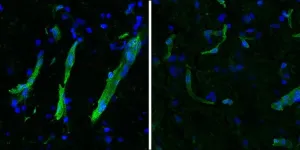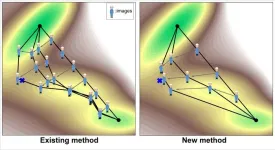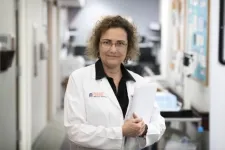(Press-News.org) On the surface, the movement disorder amyotrophic lateral sclerosis (ALS), also known as Lou Gehrig’s disease, and the cognitive disorder frontotemporal lobar degeneration (FTLD), which underlies frontotemporal dementia, manifest in very different ways. In addition, they are known to primarily affect very different regions of the brain.
However, doctors and scientists have noted several similarities over the years, and a new study in Cell reveals that the diseases have remarkable overlaps at the cellular and molecular levels, revealing potential targets that could yield therapies applicable to both disorders.
The new paper, led by scientists at MIT and the Mayo Clinic, tracked RNA expression patterns in 620,000 cells spanning 44 different cell types across motor cortex and prefrontal cortex from postmortem brain samples of 73 donors diagnosed with ALS, FTLD, or who were neurologically unaffected.
“We focused on two brain regions that we expected would be differentially affected between the two disorders,” said Manolis Kellis, co-senior author of the paper and professor in the Computer Science and Artificial Intelligence Laboratory at MIT. “It turns out that at the molecular and cellular level, the changes we found were nearly identical in the two disorders, and affected nearly identical subsets of cell types between the two regions.”
Indeed, one of the most prominent findings of the study revealed that in both diseases the most vulnerable neurons were almost identical both in the genes that they express, and in how these genes changed in expression in each disease.
“These similarities were quite striking, suggesting that therapeutics for ALS may also apply to FTLD and vice versa,” said lead corresponding author Myriam Heiman, associate professor in The Picower Institute for Learning and Memory and the Department of Brain and Cognitive Sciences at MIT. “Our study can help guide therapeutic programs that would likely be effective for both diseases.”
Heiman and Kellis collaborated with co-senior author Veronique Belzil, then associate professor of neuroscience at the Mayo Clinic Florida, now director of the ALS Research Center at Vanderbilt University.
Another key realization from the study is that brain donors with inherited vs. sporadic forms of the disease showed similarly altered gene expression changes, even though these were previously thought to have different causes. That suggests that similar molecular processes could be going awry downstream of the diseases’ origins.
“The molecular similarity between the familial (monogenic) form and the sporadic (polygenic) forms of these disorders suggests that convergence of diverse etiologies into common pathways,” Kellis said. “This has important implications for both understanding patient heterogeneity and understanding complex and rare disorders more broadly.”
‘Practically indistinguishable’ profiles
This overlap was especially evident, the study found, when looking at the most affected cells. In ALS, known to cause progressive paralysis and ultimately death, the most endangered cells in the brain are upper motor neurons (UMN) in layer 5 of the motor cortex. Meanwhile in behavioral variant frontotemporal dementia (bvFTD), the most common type of FTLD that is characterized instead by changes to personality and behavior, the most vulnerable neurons are spindle neurons, or von Economo cells, found in layer 5 of more frontal brain regions.
The new study shows that while the cells look different under the microscope, and make distinct connections in brain circuits, their gene expression in health and disease is nevertheless strikingly similar.
“UMNs and spindle neurons look nothing alike and live in very different areas of the brain” said Sebastian Pineda, lead author of the study, and a graduate student jointly supervised by Heiman and Kellis. “It was remarkable to see that they appear practically indistinguishable at the molecular level and respond very similarly to disease.”
The researchers found many of the genes involved in the two diseases implicated primary cilia, tiny antenna-like structures on the cell’s surface that sense chemical changes in the cell’s surrounding environment. Cilia are necessary for guiding the growth of axons, or long nerve fibers that neurons extend to connect with other neurons. Cells that are more dependent on this process, typically those with the longest projections, were found to be more vulnerable in each disease.
The analysis also found another type of neuron, which highly expresses the gene SCN4B and which was not previously associated with either disease, also shared many of these same characteristics and showed similar disruptions.
“It may be that changes to this poorly characterized cell population underlie various clinically-relevant disease phenomena,” Heiman said.
The study also found that the most vulnerable cells expressed genes known to be genetically-associated with each disease, providing a potential mechanistic basis for some of these genetic associations. This pattern is not always the case in neurodegenerative conditions, Heiman said. For example, Huntington’s disease is caused by a well-known mutation in the huntingtin gene, but the most highly affected neurons don’t express huntingtin more than other cells, and the same is true for some genes associated with Alzheimer’s disease.
Looking beyond neurons, the study characterized gene expression differences in many other brain cell types. Notably, researchers saw several signs of trouble in the brain’s circulatory system. The blood-brain barrier (BBB), a filtering system that tightly regulates which molecules can go into or come out of the brain through blood vessels, is believed to be compromised in both disorders.
Building on their previous characterization of human brain vasculature and its changes in Huntington’s and Alzheimer’s disease by Heiman, Kellis, and collaborators including Picower Institute Director Li-Huei Tsai, the researchers found that proteins needed to maintain blood vessel integrity are reduced or misplaced in neurodegeneration. They also found a reduction of HLA-E, a molecule thought to inhibit BBB degradation by the immune system.
Given the many molecular and mechanistic similarities in ALS and FTLD, Heiman and Kellis said they are curious why some patients present with ALS and others with FTLD, and others with both but in different orders.
While the present study examined “upper” motor neurons in the brain, Heiman and Kellis are now seeking to also characterize connected “lower” motor neurons in the spinal cord, also in collaboration with Belzil.
“Our single-cell analyses have revealed many shared biological pathways across ALS, FTLD, Huntington’s, Alzheimer’s, vascular dementia, Lewy body dementia, and several other rare neurodegenerative disorders”, says Kellis. “These common hallmarks can pave the path for a new modular approach for precision and personalized therapeutic development, which can bring much-needed new insights and hope.”
In addition to Pineda, Belzil, Kellis and Heiman, the study’s other authors are Hyeseung Lee, Maria Ulloa-Navas, Raleigh Linville, Francisco Garcia, Kyriaktisa Galani, Erica Engelberg-Cook, Monica Castanedes, Brent Fitzwalter, Luc Pregent, Mahammad Gardashli, Michael DeTure, Diana Vera-Garcia, Andre Hucke, Bjorn Oskarsson, Melissa Murray and Dennis Dickson.
Support for the study came from the National Institutes of Health, Mitsubishi Tanabe Pharma Holdings, The JPB Foundation, The Picower Institute for Learning and Memory, the Robert Packard Center for ALS Research at Johns Hopkins, The LiveLikeLou Foundation, the Gerstner Family Foundation, The Mayo Clinic Center for Individualized Medicine, and the Cure Alzheimer’s Fund.
END
Movement disorder ALS and cognitive disorder FTLD show strong molecular overlaps, new study shows
Single-cell gene expression patterns in the brain motor and frontal cortex, and evidence from follow-up experiments, reveal many shared cellular and molecular similarities that could be targeted for potential treatment
2024-03-22
ELSE PRESS RELEASES FROM THIS DATE:
Patient characteristics and telemedicine use in the US, 2022
2024-03-22
About The Study: In this study of 5,437 U.S. adults with health care visits in 2022, many patients, including those with the greatest care needs, chose telemedicine even after in-person visits were available. These findings support continuing this care delivery approach as an option valued by patients. Differences were not observed by most common measures of socioeconomic status. Continued monitoring of telemedicine use is needed to ensure equitable access to health care innovations.
Authors: Eva ...
Racial and ethnic differences in telemedicine use
2024-03-22
About The Study: The results of this study of Medicare enrollees suggest that although nationally, Black and Hispanic individuals and individuals of other racial groups received more telemedicine visits during the pandemic and disproportionately lived in geographic regions with higher telemedicine use, after controlling for geographic region, Black and Hispanic individuals and individuals of other racial groups received fewer telemedicine visits than white individuals.
Authors: Felippe O. Marcondes, M.D., M.P.H., of Massachusetts General ...
Most new doctors face some form of sexual harassment, even after #MeToo
2024-03-22
More than half of all new doctors face some form of sexual harassment in their first year on the job, including nearly three-quarters of all new female doctors and a third of males, a new study finds.
That’s actually down somewhat from the percentage of new doctors who experienced the same five or six years before, according to the paper published in JAMA Health Forum by a team from the University of Michigan Medical School and Medical University of South Carolina.
And today’s ...
Researchers propose a new way to identify when babies become conscious
2024-03-22
Academics are proposing a new and improved way to help researchers discover when consciousness emerges in human infancy.
When over the course of development do humans become conscious? When the seventeenth-century French philosopher René Descartes was asked about infant consciousness by his critics, he eventually suggested that infants might have thoughts, albeit ones that are simpler than those of adults. Hundreds of years later, the issue of when human beings become conscious is a question which remains a challenge for psychologists and philosophers alike.
But now, in response to a recent ...
A reliable and efficient computational method for finding transition states in chemical reactions
2024-03-22
A computational method for finding transition states in chemical reactions, greatly reducing computational costs with high reliability, has been devised. Compared to the most widely used existing method, the present method reduces the total computational cost by approximately 50 to 70%. The development, available on GitHub, is poised to accelerate advancements in material science, making the exploration of chemical reactions more accessible and efficient. This could lead to faster scientific discoveries and technological innovations.
In chemical reactions, substances ...
Multiple unsafe sleep practices found in most sudden infant deaths
2024-03-22
There were multiple unsafe sleep practices at play in more than three-quarters of Sudden Unexpected Infant Deaths reported in 23 jurisdictions between 2011 and 2020, a new study reveals. The researchers say the findings underscore the need for more comprehensive safe-sleep education for new parents, including from healthcare providers.
Of 7,595 infant deaths reviewed, almost 60% of the infants were sharing a sleep surface, such as a bed, when they died. This practice is strongly discouraged by sleep experts, who warn that a parent or other bed partner could unintentionally ...
MD Anderson’s Institute for Data Science in Oncology announces appointment of inaugural IDSO Affiliates
2024-03-22
HOUSTON ― The Institute for Data Science in Oncology (IDSO) at The University of Texas MD Anderson Cancer Center today announced the appointment of its inaugural cohort of IDSO Affiliates. These 33 talented scientists, clinicians and staff bring diverse expertise to help IDSO leadership and focus area co-leads advance collaborative data science projects and align the institute’s efforts with MD Anderson’s mission to end cancer.
“We are proud to welcome these exceptional individuals to the growing IDSO community, and we look forward ...
B4C@TiB2 core–shell structural units show outstanding toughening effect for Al2O3 ceramics
2024-03-22
Toughening has always been an important research direction of structure ceramics. The addition of secondary phases to the ceramic matrix to prepare composite ceramics is an effective toughening pathway in the field of structure ceramics. Both phase-type and microstructure of the secondary phases play a decisive role in the toughening effect of the ceramic matrix. Being different from the conventional independent phase as the secondary phase, B4C@TiB2 core–shell structural unit has been purposely designed as an innovative kind of secondary phase to toughen the Al2O3 ceramic matrix, providing a new concept for the toughening studies of structural ceramics.
A ...
Messenger RNAs with multiple “tails” could lead to more effective therapeutics
2024-03-22
Messenger RNA (mRNA) made its big leap into the public limelight during the pandemic, thanks to its cornerstone role in several COVID-19 vaccines. But mRNAs, which are genetic sequences that instruct the body to produce proteins, are also being developed as a new class of drugs. For mRNAs to have broad therapeutic uses, however, the molecules will need to last longer in the body than those that make up the COVID vaccines.
Researchers from the Broad Institute of MIT and Harvard and MIT have engineered a ...
3D images reveal link between crack complexity and material toughness
2024-03-22
The last time you dropped a favorite mug or sat on your glasses, you may have been too preoccupied to take much notice of the intricate pattern of cracks that appeared in the broken object. But capturing the formation of such patterns is the specialty of John Kolinski and his team at the Laboratory of Engineering Mechanics of Soft Interfaces (EMSI) in EPFL’s School of Engineering. They aim to understand how cracks propagate in brittle solids, which is essential for developing and testing safe and cost-effective composite materials for use in construction, sports, and aerospace engineering.
But traditional mechanics approaches to analyzing crack formation assume ...
LAST 30 PRESS RELEASES:
The Ceramic Society of Japan’s Oxoate Ceramics Research Association launches new international book project
Heart-brain connection: international study reveals the role of the vagus nerve in keeping the heart young
Researchers identify Rb1 as a predictive biomarker for a new therapeutic strategy in some breast cancers
Survey reveals ethical gaps slowing AI adoption in pediatric surgery
Stimulant ADHD medications work differently than thought
AI overestimates how smart people are, according to HSE economists
HSE researchers create genome-wide map of quadruplexes
Scientists boost cell "powerhouses" to burn more calories
Automatic label checking: The missing step in making reliable medical AI
Low daily alcohol intake linked to 50% heightened mouth cancer risk in India
American Meteorological Society announces Rick Spinrad as 2026 President-Elect
Biomass-based carbon capture spotlighted in newly released global climate webinar recording
Illuminating invisible nano pollutants: advanced bioimaging tracks the full journey of emerging nanoscale contaminants in living systems
How does age affect recovery from spinal cord injury?
Novel AI tool offers prognosis for patients with head and neck cancer
Fathers’ microplastic exposure tied to their children’s metabolic problems
Research validates laboratory model for studying high-grade serous ovarian cancer
SIR 2026 delivers transformative breakthroughs in minimally invasive medicine to improve patient care
Stem Cell Reports most downloaded papers of 2025 highlight the breadth and impact of stem cell research
Oxford-led study estimates NHS spends around 3% of its primary and secondary care budget on the health impacts of heat and cold in England
A researcher’s long quest leads to a smart composite breakthrough
Urban wild bees act as “microbial sensors” of city health.
New study finds where you live affects recovery after a hip fracture
Forecasting the impact of fully automated vehicle adoption on US road traffic injuries
Alcohol-related hospitalizations from 2016 to 2022
Semaglutide and hospitalizations in patients with obesity and established cardiovascular disease
Researchers ‘listen in’ to embryo-mother interactions during implantation using a culture system replicating the womb lining
How changing your diet could help save the world
How to make AI truly scalable and reliable for real-time traffic assignment?
Beyond fragmented markets: A new framework for efficient and stable ride-pooling
[Press-News.org] Movement disorder ALS and cognitive disorder FTLD show strong molecular overlaps, new study showsSingle-cell gene expression patterns in the brain motor and frontal cortex, and evidence from follow-up experiments, reveal many shared cellular and molecular similarities that could be targeted for potential treatment





